Last Updated on January 5, 2024 by Greg Gillson
I’ve put this resource together for you to answer your question: What birds are in my backyard in Illinois?
These are the most common backyard birds in Illinois:
- American Robin
- Northern Cardinal
- Red-winged Blackbird
- American Goldfinch
- Mourning Dove
- European Starling
- House Sparrow
- Downy Woodpecker
- Black-capped Chickadee
- Blue Jay
- American Crow
- Song Sparrow
- Red-bellied Woodpecker
- Common Grackle
- White-breasted Nuthatch
- House Finch
- Dark-eyed Junco
- American Tree Sparrow
- Indigo Bunting
- Barn Swallow
- Gray Catbird
- House Wren
- Tree Swallow
- Eastern Wood-Pewee
- Cedar Waxwing
- Brown-headed Cowbird
- Northern Flicker
Illinois Birds and Birding in Illinois State
As one of the states in the region of the Midwest and on the Central Flyway for migration, Illinois has abundant bird life. eBird lists over 440 types of birds as occurring in the state of Illinois.
The most common bird in Illinois: the most frequently seen bird in the state is a tie: American Robin and Northern Cardinal. These two species are reported on 49% of bird watching lists.
If you are serious about knowing the birds native to Illinois, then check out eBird for Illinois. It has recent sightings and photos, illustrated checklists with weekly abundance bar charts for state, counties, and individual hotspots of the best birding locations.
If you want to know about other people interested in birds in your area, join a local bird group. The American Birding Association maintains a list of bird watching clubs for each state.
Illinois Bird Identification
This section is the species accounts. These are designed to help you to recognize birds you see in your backyard. I have used eBird to select the birds that are most common. “Common” means the birds seen most often throughout the year, not necessarily the most numerous.
Each species account starts with a photograph. In the identification section I am using size and shape and bill type before considering the color or patterns on the birds. I find these more reliable when trying to identify an unknown bird. Pay attention to body and tail shape and especially bill shape of birds you see, not just plumage color.
In the section on bird feeders and foods I tell how to attract each species. Not all types of backyard birds will come to feeders. But all backyard birds can be attracted with water. So don’t forget to add a birdbath to your bird feeding station.
Do you live in northern Illinois? Southern Illinois? Central Illinois? To appear in this article, most birds are widely distributed throughout the state and are often year-round residents. However, for those birds that are more localized in place or time, I list the general region and seasonality. Please see the section following these species accounts for the lists of common species by season.
Even if a species is found in a general area, they occur only in the habitat they prefer. So, the exact habitat of your neighborhood is important for the presence of absence of certain kinds of birds.
1. American Robin (Turdus migratorius)
This familiar bird is a common backyard resident in the northern half of the United States and a winter visitor in the southern half.
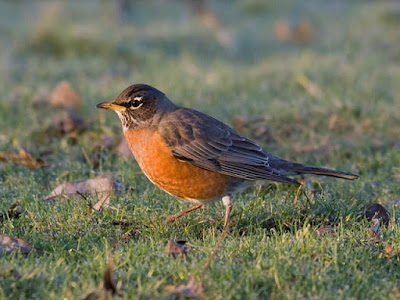 |
| American Robin. Greg Gillson |
Range in Illinois: American Robins are year-round residents in most of Illinois, summer residents only in northern Illinois.
Identification: This is a key species for comparing with an unknown bird.
Size: 10 inches long from bill tip to tail tip. About the same size as a Blue Jay or one of the Scrub-Jays. Larger than Red-winged Blackbird. Smaller than a Mourning Dove.
Shape: Very plump with a fairly long tail.
Bill: Straight and fairly slender, curved at the tip.
Color: Gray-brown upperparts, rusty orange breast.
Habitat, range & behavior: Open woodlands, farmlands, urban parks and lawns.
Migratory, breeds north across Alaska and Canada. Resident in most of the United States (lower 48). Winters in the United States, Mexico, to central America.
Hops on your lawn turning head this way and that looking for food. Their caroling song is one of the early signs of spring in the north.
Food and feeder preference: Worms and other invertebrates in the lawn. May eat fruit from a tray feeder or the ground. Eat small berries from trees and bushes.
2. Northern Cardinal (Cardinalis cardinalis)
This is one of the most common and popular backyard birds in the eastern half of the United States.
 |
| Northern Cardinal. GeorgeB2 Pixaby |
Range in Illinois: Northern Cardinals are year-round residents throughout most of Illinois, absent in far north of state.
Identification:
Size: Cardinals are a bit smaller than American Robins, about the same size as Red-winged Blackbirds.
Shape: Plump body with fairly long full tail. Wispy crest.
Bill: Short, heavy, conical, pink.
Color: That bright red color is matched by few other birds. Black face. The female is more gray, but with hints of red in wings and tail, and has a crest, too.
Habitat, range & behavior: Cardinals are year-round residents in shrubby woodland edges.
Found from the eastern United States to Texas and Arizona south into Mexico.
That large conical bill is made for chewing seeds. Watch them crack open sunflower seeds, spit out the hulls, and pluck the kernel with their tongues!
Food and feeder preference: Attract with black oil sunflower seeds. Many types of seeds, berries, nuts in larger hopper or tray feeders.
You may like my in-depth article on attracting Northern Cardinals.
3. Red-winged Blackbird (Agelaius phoeniceus)
These noisy flocking birds are most often found in marshes. But in winter they are found in backyards.
 |
| Male Red-winged Blackbird. Greg Gillson. |
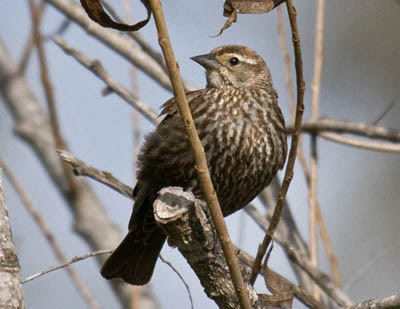 |
| Female Red-winged Blackbird. Greg Gillson. |
Range in Illinois: Red-winged Blackbirds are year-round residents throughout Illinois.
Identification: This is a key species for comparing with an unknown bird.
Size: About 8-3/4 inches long from bill tip to tail tip. About the size of a Northern Cardinal. Smaller than an American Robin.
Shape: Pot-bellied with a longer bill and flat forehead. Tail average.
Bill: Long and sharp pointed.
Color: Males are black with red and yellow shoulder patch. Females are streaked brown and rusty (sparrow-like but pointed bill and flat forehead).
Habitat, range, and behavior: Cattail marshes and wetlands are their summer habitat. In winter they feed in grain fields.
They breed across most of the North American continent. In winter they withdraw from most of Alaska and Canada.
They are found in colonies in summer and large flocks in winter.
Food and feeder preference: They eat insects in summer. In winter they eat grain and seeds. They visit feeders, more often in large winter flocks, and eat most seeds and suet.
4. American Goldfinch (Spinus tristis)
This common backyard bird is a beautiful tiny finch familiar to many in its bright yellow summer plumage. Colloquially called a “wild canary.”
 |
| American Goldfinch. Greg Gillson |
Range in Illinois: American Goldfinches are year-round residents throughout Illinois.
Identification: This is a key species for comparing with an unknown bird.
Size: Very small at about 5 inches from bill tip to tail tip. Similar in size to a chickadee. Larger than hummingbirds. Smaller than juncos and House Finches.
Shape: Tiny, somewhat plump with larger head and short tail.
Bill: Short, conical, pink.
Color: Males in summer are bright lemon yellow with black forehead and black wings and tail with white bars. White under tail coverts. Females are dull olive, wings and tail browner. Winter birds are pale grayish-yellow with tan and brown wings and tail.
Habitat, range & behavior: This species is found in weedy fields and similar clearings with thistles and similar plants.
It is found coast-to-coast throughout the year across most of the middle lower-48 states. In summer moves north to the Canada border. In the winter found south to the Mexico border.
The flight is highly undulating, rising and falling as they flap in short bursts. Besides a long, sweet lilting song, they call in flight a lilting 4-part: “potato chip!”
Food and feeder preference: Feeds on weed seeds, thistle seed. May eat black oil sunflower seeds from tube feeder. Attract with Niger seed in a feeder called a “thistle sock.”
You may like my in-depth article on attracting American Goldfinches.
5. Mourning Dove (Zenaida macroura)
Mourning Doves are the most widespread and most frequent backyard bird in the Lower 48 states of the United States.
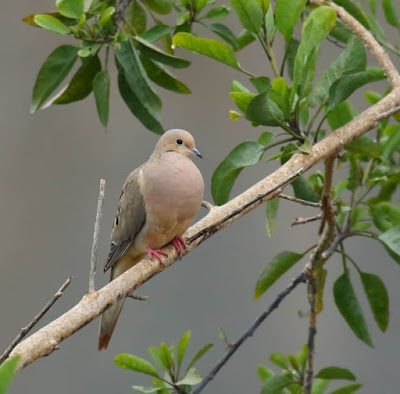 |
| Mourning Dove. Greg Gillson |
Range in Illinois: Mourning Doves are year-round residents in most of Illinois, summer residents only in the northern part of the state.
Identification: This is a key species for comparing with an unknown bird.
Size: About 12 inches long from bill tip to tail tip. About same size as Northern Flicker. Larger than American Robin. Slightly smaller than domestic city pigeon.
Shape: Very plump with a small round head. Tail is long and pointed. Legs are short.
Bill: Small and rather slender.
Color: Pale brown-pink body, darker wings and tail. White edges on side of tail.
Habitat, range & behavior: Semi-open areas such as urban areas, farmlands, woods. Often seen perched on wires, fences.
It is a resident across the lower-48 states and Mexico, with some movement out of northern areas in winter.
Their mournful cooing is a familiar spring birdsong.
Food and feeder preference: Mourning Doves eat seeds almost exclusively. Attract with black oil sunflower seeds on a large sturdy tray feeder or on the ground.
6. European Starling (Sturnus vulgaris)
Introduced to North America in the late 1800’s, they crossed the continent, often to the detriment of native cavity-nesting birds. The prime example of an invasive species.
 |
| European Starling. Greg Gillson |
Range in Illinois: European Starlings are year-round residents throughout Illinois.
Identification: This is a key species for comparing with an unknown bird.
Size: 8-1/2 inches from bill tip to tail tip. About the size of a Red-winged Blackbird. Smaller than an American Robin. Larger than a White-crowned Sparrow or Spotted/Eastern towhee.
Shape: Stocky with large head, short square-ended tail. Longer legs.
Bill: As long as head. Sharp pointed. Yellow in spring, otherwise dark.
Color: They are grayish brown much of the year, with glossy iridescence and white spotting during the spring.
Habitat, range & behavior: Lowland birds that need trees large enough for nest cavities but plenty of open area for feeding. They are most abundant in urban and suburban areas where they find food and artificial nest cavities.
Resident from coast-to-coast from southern Canada to northern Mexico. In summer north across Canada and Alaska. Native range is Europe to Pakistan, north Africa.
Often viewed as a pest, starlings often bully other backyard birds, taking over bird feeders, and stealing nest cavities from smaller native birds. In winter they can form into flocks of ten’s of thousands.
Food and feeder preference: Primarily insects when available, often feeding on the ground. Discourage them from your backyard hopper and tray feeders by never feeding birds table scraps (including bread or meat). They have weak feet and do not perch well on tube feeders. A cage mesh around smaller hopper feeders may keep them out.
7. House Sparrow (Passer domesticus)
Like the starling, this is another bird introduced from Europe in the 1800’s. This sparrow is commonly found in cities and farmlands. It is considered a pest in most areas where it has been introduced.
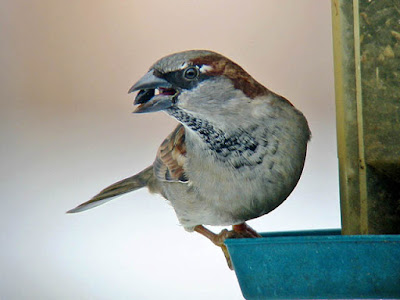 |
| House Sparrow. Greg Gillson |
Range in Illinois: House Sparrows are year-round residents throughout Illinois.
Identification:
Size: The size of a House Finch or Dark-eyed Junco.
Shape: Chunkier than native North American sparrows with large head, barrel chest, short neck, medium tail, short legs.
Bill: Short, conical.
Color: Males are brown and gray with a black mask. Females lack the black and are tan and brown with a pale line back from the eye.
Habitat, range & behavior: Cities and farms.
Range in North American from southern Canada through Central America. In summer northward through Canada to southern Alaska. Originated in Middle East and spread to most of Europe and Asia. Introduced in South America, Africa, Australia–nearly anywhere there are people and cities.
They tend to be messy… and have a good appetite, and may occur in large noisy chirping flocks. They are aggressive toward other feeder birds.
Food and feeder preference: They eat grain, seed, and insects. To discourage them from your hopper and tray feeders do not feed birds human food scraps. They have a bit of difficulty eating from tube feeders.
8. Downy Woodpecker (Dryobates pubescens)
This tiny woodpecker is found in backyards across the United States.
 |
| Downy Woodpecker. Greg Gillson |
Range in Illinois: Downy Woodpeckers are year-round residents throughout Illinois.
Identification:
Size: Bigger than a junco or House Finch. Smaller than a Red-winged Blackbird. About the same size as a White-crowned Sparrow, but with a much shorter tail.
Shape: Stocky with large head and short stiff tail.
Bill: Short, chisel-shaped.
Color: Black-and-white striped head. Black wings with white spots. Solid white back. White under parts. Black tail with white outer tail feathers with black bars or spots. Male with small red spot at back of head.
Habitat, range & behavior: Found in small deciduous trees, willows, and even weed stocks such as teasel, especially near water.
Ranges coast-to-coast across all but northernmost parts of Canada and Alaska south to the southern US. Absent in the desert southwest.
Interestingly, I learned today that the males may more often be found in smaller plants and twigs, while females are more likely on tree trunks.
Food and feeder preference: Insects, fruits, and seeds. Gleans arthropods from the bark of trees. Attract with suet feeder. Will also eat black oil sunflower seeds.
9. Black-capped Chickadee (Poecile atricapillus)
This is a common backyard bird in the northern half of the United States.
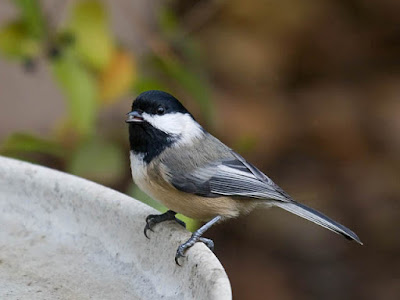 |
| Black-capped Chickadee. Greg Gillson |
Range in Illinois: Black-capped Chickadees are year-round residents throughout Illinois.
Identification:
Size: Chickadees are small birds, the same general size as an American Goldfinch.
Shape: Round body, big round head, long tail with rounded tip.
Bill: Short, straight, stout.
Color: Gray above, buffy below. Black cap and bib with white lower face. White edges on wing feathers.
Habitat, range & behavior: Deciduous and mixed forests.
They range from the northern half of the United States, southern half of Canada, and most of Alaska.
Small flocks flit actively from tree to tree acrobatically gleaning insects from twig tips. In winter chickadees make up the core of mixed-species flocks also containing nuthatches, kinglets, creepers, woodpeckers and others.
Food and feeder preference: Seeds, insects, berries. They eat at tube, hopper and tray feeders. They love black oil sunflower seeds and are attracted to suet.
You may like my in-depth article on attracting Black-capped Chickadees.
10. Blue Jay (Cyanocitta cristata)
A common and well-known bird in the eastern half of the United States.
 |
| Blue Jay. skeeze Pixabay |
Range in Illinois: Blue Jays are year-round residents throughout Illinois.
Identification:
Size: About that of American Robin.
Shape: Fluffy, large crested head, ample tail. Large strong legs.
Bill: Black, long and stout.
Color: Blue above, white below. Black neck collar. White patches in wing.
Habitat, range & behavior: Woodlands and towns.
They live in the eastern half of the United States. In summer into southern Canada.
Bold and brash. May bully smaller birds. Jays gulp lots of seeds or other food at once, storing it in their crop. Then they fly off and bury food items in a hidden cache.
Food and feeder preference: Omnivorous. They can quickly empty your feeder! Because they are also aggressive toward other feeder birds, some people put mesh cages around smaller bird feeders. Small birds can go through, squirrels and larger “pest” birds are prevented entry. Some people feed jays peanuts, perhaps away from the seed feeders.
11. American Crow (Corvus brachyrhynchos)
This larger all-black bird is common in cities and country. Its cawing call is familiar to most people.
 |
| American Crow. Greg Gillson |
Range in Illinois: American Crows are year-round residents throughout Illinois.
Identification: This is a key species for comparing with an unknown bird.
Size: About 17-1/2 inches long from bill tip to tail tip, though there is much size variation throughout its range. Larger than blackbirds and grackles. Smaller than ravens.
Shape: Thick neck, large head, rather short square-ended tail. Longer legs. In flight has rounded wing tips with each primary feather separated from others forming “fingers.”
Bill: As long as head, thick, black.
Color: Glossy black throughout.
Habitat, range & behavior: They prefer open areas with trees, fields, farms, cities.
They are common across most of the United States lower-48, except in the desert southwest. They move into southern Canada in summer.
They gather in evening communal roosts in large flocks that may number into the thousands and then move out at dawn into the surrounding area.
Food and feeder preference: Omnivorous, they feed on large insects, grain, small mammals, carrion. You probably don’t want these large entirely black birds in your backyard feeders. So don’t feed table scraps to birds.
12. Song Sparrow (Melospiza melodia)
A common bird, but variable, and similar to many other streaked brown sparrows.
 |
| Song Sparrow. Greg Gillson |
Range in Illinois: Song Sparrows are year-round residents in southern Illinois, summer residents only in northern Illinois.
Identification:
Size: A smaller bird, similar in size to House Finch and juncos. Larger than chickadees and goldfinches. Smaller than White-crowned Sparrows or Spotted/Eastern towhees.
Shape: Plump with round head, long rounded tail.
Bill: Short, conical.
Color: Highly variable in darkness and color saturation across its range (dark rusty to pale gray). Generally gray-brown above with dark brown streaking on back. Complicated head pattern. Streaking on sides and breast converge into dense central breast spot.
Habitat, range & behavior: Thickets, especially near water. Backyard shrubbery.
Resident in western United States, western Canada, coastal southern Alaska, northeastern US. In summer also moves into mid-Canada and northern half of US. In the winter found in most of the US lower-48. Also a population in central Mexico.
Forages on ground, never far from low cover to which they fly if startled.
Food and feeder preference: They feed on seeds and insects near the ground. Will visit hopper and tray feeders for mixed bird seed.
13. Red-bellied Woodpecker (Melanerpes carolinus)
This is one of the most common species in the eastern half of the United States.
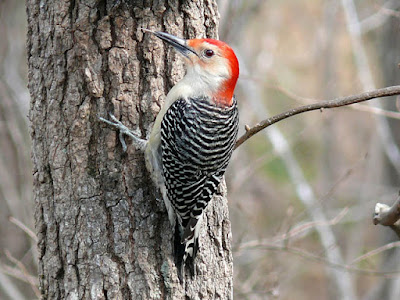 |
| Red-bellied Woodpecker. skeeze Pixabay |
Range in Illinois: Red-bellied Woodpeckers are year-round residents through most of Illinois, absent in northern Illinois
Identification:
Size: Fairly large for a backyard bird. Between a Starling and American Robin in size. Smaller than a Northern Flicker.
Shape: Stout with large head and short tail. Clings to tree trunk on strong short legs propped up with short stiff tail.
Bill: Long, chisel-shaped.
Color: Pale gray body, many thin black-and-white bars across back and wings. Red nape, extending forward on crown on male.
Habitat, range & behavior: These birds are found in many woodland types, including oak, hickory and pine.
They are found from the eastern slope of the Rocky Mountains in the lower-48 states from Texas to extreme southern Canada, and eastward from Florida northward just to the southern edge of the New England states.
In typical woodpecker fashion, it hitches up the tree trunk and larger branches.
Food and feeder preference: This species eats insects and nuts. They may eat peanuts from a tray feeder and attract with a suet block.
14. Common Grackle (Quiscalus quiscula)
Sometimes considered a pest to crops, grackles are longer and lankier than very similar blackbirds.
 |
| Common Grackle. GeorgiaLens Pixabay |
Range in Illinois: Common Grackles are summer residents throughout most of Illinois, year-round residents in southern Illinois.
Identification:
Size: Larger than Red-winged Blackbirds, they are near the length of Mourning Doves.
Shape: Long, with long full keel-shaped tail, long legs, flat crown.
Bill: Longer than head, pointed, but stouter than other blackbirds.
Color: Glossy black with hint of bronze or green on head (depending upon population). Yellow eye.
Habitat, range & behavior: They are found in agricultural areas, woodland edges, city parks and lawns.
Resident in the southeastern United States. In summer they migrate northward and west to the central United States and Canada.
They monopolize feeders and are bullies toward other birds.
Food and feeder preference: Grain, corn, acorns, small aquatic fish and amphibians. To discourage them, use tube feeders, rather than hopper or tray feeders. Don’t over-feed, keep spilled seed picked up.
15. White-breasted Nuthatch (Sitta carolinensis)
A favorite backyard feeder bird for many for its active antics and fearlessness. Though a small bird it is the largest nuthatch in North America.
 |
| White-breasted Nuthatch. Greg Gillson |
Range in Illinois: White-breasted Nuthatches are year-round residents throughout Illinois.
Identification:
Size: About chickadee-sized in length. Smaller than a junco or House Finch.
Shape: Appears large-headed, neckless, very short tailed. Short legs.
Bill: Nearly as long as head, straight, thin.
Color: Blue-gray above, white below. Black cap, wing tips, tail. Rusty feathers under tail.
Habitat, range & behavior: Common in oak and oak-pine woodlands, wooded towns.
Found across the United States, southern Canada, mountains of central Mexico. Absent from treeless grasslands, deserts in the west.
Crawls over tree branches and head-first down tree trunks searching for insects.
Food and feeder preference: Insects, seeds, acorns and other nuts. Attract with black oil sunflower seeds feeding on hopper and tray feeders. Suet blocks.
16. House Finch (Haemorhous mexicanus)
Originally a bird of the West, now common in backyards across most of the US. There are other red finches, but these are the ones most likely in residential areas.
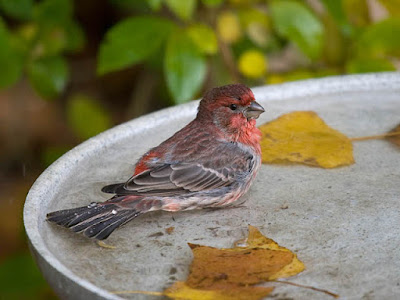 |
| House Finch. Greg Gillson |
Range in Illinois: House Finches are year-round residents in southern and eastern Illinois, absent elsewhere.
Identification: This is a key species for comparing with an unknown bird.
Size: About 6 inches from bill tip to tail tip. Larger than goldfinches and chickadees. Smaller than a White-crowned Sparrows or Spotted/Eastern towhees.
Shape: Medium build with a medium-long notched tail. Round head.
Bill: Short, conical.
Color: Brown and gray above with streaks on the sides of the pale underparts. Males with red (sometimes orange or rarely yellow) crown, chest, rump.
Habitat, range & behavior: You’ll find small flocks on wires, in short tree tops and in bushes. Originally deserts and grasslands. Rural areas and towns are where they’re now most common.
Formerly found in the western United States and Mexico. Then introduced into the northeastern United States, but now found in nearly all of the lower-48 states and extreme southern Canada. Rare in plains states (Dakotas to Texas) and southern Florida.
House Finches are not territorial, but males sing throughout the year–a lively, wiry song ending in a couple of buzzy notes.
Food and feeder preference: Attract with sunflower seeds and tube feeders. May eat from thistle socks.
You may like my in-depth article on attracting House Finches.
17. Dark-eyed Junco (Junco hyemalis)
Colloquially called “snowbirds,” they often arrive in backyards in winter from nearby mountain forests or more northern climes.
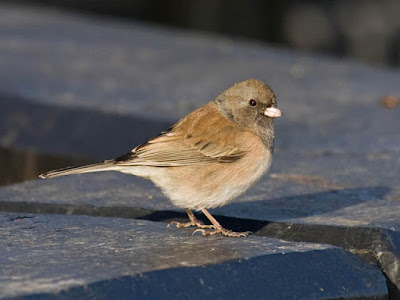 |
| Dark-eyed Junco. Greg Gillson. |
Range in Illinois: Dark-eyed Juncos are year-round residents in northern Illinois, winter visitors only throughout the rest of the state.
Identification:
Size: Small birds about the size of a House Finch.
Shape: Round body, short neck, round head, fairly long square-ended tail.
Bill: Short, pointed, conical, pink.
Color: Eastern birds are a darker all-gray with white belly. Western birds (pictured above) have jet black hood over the head, brown back, white belly and pink sides. Females paler.
Habitat, range & behavior: Breed in coniferous forests. Winters widely. Avoids heavy brush, preferring widely spaced bushes.
Breeds across most of Canada, Alaska, and the western half of the United States. Winters from southern Canada and all of the lower 48-states to extreme northern Mexico.
Spend much of their time hopping and feeding on the ground.
Food and feeder preference: Dark-eyed Juncos eat mostly seeds, also insects in summer. Readily feed at backyard feeders on mixed seeds on hopper or tray feeders and ground.
You may like my in-depth article on attracting Dark-eyed Juncos.
18. American Tree Sparrow (Spizelloides arborea)
These birds nest at the edge of the tundra. Don’t expect the first ones in fall until late October, at least.
 |
| American Tree Sparrow. Greg Gillson. |
Range in Illinois: American Trees Sparrows are winter visitors throughout Illinois.
Identification:
Size: These are smaller sparrows, the size of juncos.
Shape: Small roundish body, rounded head, long tail.
Bill: Small conical. Bicolored–dark upper and yellow under mandibles.
Color: Pale gray breast and face. Rusty back, wings, crown, line back from eye. Two white wing bars. Dark central breast spot.
Habitat, range & behavior: In winter they like open weedy fields with small trees.
Breed in Alaska and northern Canada. Winter in northern half of the United States.
These birds spend much more time on the ground than in trees.
Food and feeder preference: They visit feeders for small seeds, but spend more time on the ground under the feeders.
19. Indigo Bunting (Passerina cyanea)
Don’t mistake Indigo Buntings for the larger Blue Grosbeak. As the name suggests, the grosbeak has a much larger and thicker bill, along with rusty wing bars, lacking in Indigo Buntings.
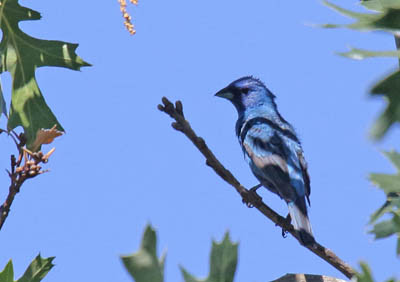 |
| Indigo Bunting. Greg Gillson. |
Range in Illinois: Indigo Buntings are summer residents throughout Illinois.
Identification:
Size: These birds are a bit smaller than a House Sparrow.
Shape: Plump. Large round head. Medium short tail.
Bill: Large and conical.
Color: Males are deep blue. Females are pale gray-brown with diffuse streaks below.
Habitat, range & behavior: Open woodlands and clearings. Country farm roads.
They are found in the East and parts of the Southwest, north to southern Canada.
Sing from the tallest tip of tree or telephone lines, a cheerful paired bouncy song very similar to American Goldfinch. In fact, they are sometimes called “blue goldfinches” because of this!
Food and feeder preference: These birds will eat seeds from hopper feeders, perhaps more so in the late spring when they first arrive during migration.
20. Barn Swallow (Hirundo rustica)
These common swallows are widely distributed throughout the world, primarily breeding in the northern hemisphere, and wintering in the mid-latitudes and southern hemisphere.
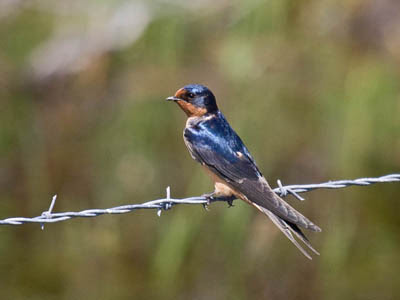 |
| Barn Swallow. Greg Gillson. |
Range in Illinois: Barn Swallows are summer residents throughout Illinois.
Identification:
Size: About the size of a House Finch but with a much longer tail.
Shape: Stocky, short necked but with long body and tail. Tail is forked, with very long outer tail feathers. Wings pointed.
Bill: Short, wide.
Color: Glossy dark purplish-blue above. Pinkish-orange below.
Habitat, range & behavior: Barn Swallows live in open country, frequently near humans. Farmlands. Nest in barns, under small bridges.
In North America breed from Mexico to northern Canada and Alaska, wintering from southern Mexico throughout most of South America.
Frequently seen swooping low over the ground hunting flying insects. Perch on wires, fences. Voice is twitters and chirps with grating sounds.
Food and feeder preference: Eat flying insects on the wing and are not attracted to backyard feeders.
21. Gray Catbird (Dumatella carolinensis)
This bird is rather common where it occurs, but a bit secretive.
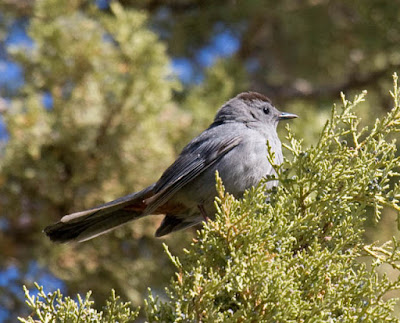 |
| Gray Catbird. Greg Gillson |
Range in Illinois: Gray Catbirds are summer residents throughout Illinois.
Identification:
Size: About the length of a Red-winged Blackbird or Northern Cardinal.
Shape: Long tailed, round head.
Bill: Medium-length, pointed.
Color: Gray with a black tail and black cap. Rusty under tail coverts.
Habitat, range & behavior: Dense woodland edges, scrub, abandoned orchards.
Breeds in eastern and central US and adjoining southern Canada. Winters in extreme south US Gulf states, southward in eastern Mexico to Panama.
They spend much time hopping on the ground or in low bushes. They defend a winter territory, unlike most birds.
Food and feeder preference: Insects and berries. You may attract this species with jelly and fruit feeders, suet, and water.
22. House Wren (Troglodytes aedon)
These backyard birds will readily use nest boxes to raise their young.
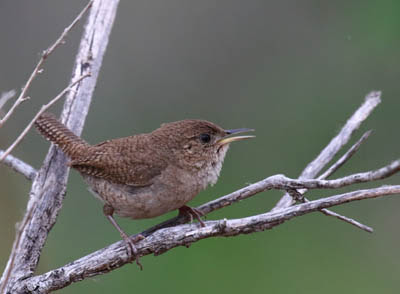 |
| House Wren. Greg Gillson. |
Range in Illinois: House Wrens are summer residents throughout Illinois.
Identification:
Size: About the size of Black-capped Chickadee but with shorter tail.
Shape: Round body. Large head. Thin short tail.
Bill: Fairly long, thin, slightly down curved. Sharply pointed.
Color: Rather dull brownish-gray throughout. Paler throat and breast. Tail barred with black and pale bars along with the brown.
Habitat, range & behavior: Brushy areas, woodland edges, hedge rows, tree stumps in logged areas.
Breed across Canada and the northern and mid-latitudes of the United States. Winter to the southern United States and through Mexico. Found year round at southern edge of breeding range: California, North Carolina to northern Alabama, southern Arizona south through mountains of Mexico.
Stay hidden in brushy areas. Hop among tree roots, logged stumps.
Food and feeder preference: May feed at suet feeder.
23. Tree Swallow (Tachycineta bicolor)
Look for these common birds high in the air or swooping low over the water chasing flying insects.
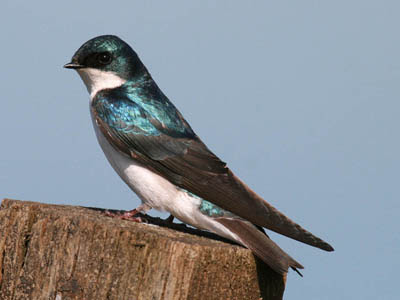 |
| Tree Swallow. Greg Gillson. |
Range in illinois: Tree Swallows are summer residents throughout Illinois.
Identification:
Size: These birds are rather small, about the length of American Goldfinches.
Shape: Long body with short tail. Neck short. Wings long and pointed.
Bill: Very short, but wide.
Color: These birds are shiny metallic blue above and bright white below. Males have a black mask.
Habitat, range & behavior: These birds are almost always found near or over water.
They breed in summer across almost all of North America, Alaska across Canada and south throughout all but the dry southwestern deserts and southernmost states of the United States. In winter they are found along southern coastal states, southward into Mexico.
Look for Tree Swallows swooping high or low over ponds, lakes, wetlands.
Food and feeder preference: Tree Swallows chase flying insects and feed on the wing.
24. Eastern Wood-Pewee (Contopus virens)
Eastern Wood-Pewees and Western Wood-Pewees appear very similar. Their ranges nearly split the continent in half, east and west. Their song separates them; it is a clear whistled pee-a-wee in the Eastern Wood-Pewee, and a burry pee-yeear in the Western Wood-Pewee.
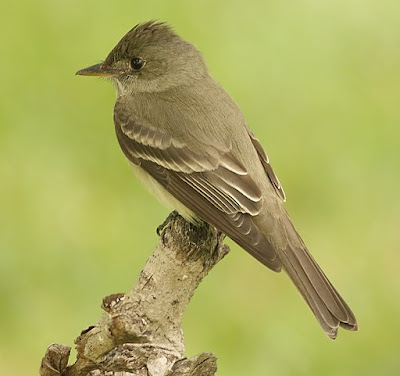 |
| Eastern Wood-Pewee. Tony Castro CC 4.0 |
Range in Illinois: Eastern Wood-Pewees are summer residents throughout Illinois.
Identification:
Size: Bigger than a House Finch; smaller than a bluebird.
Shape: Upright posture. Large head. Thick chest. Long tail. Long wings.
Bill: Medium length, wide at base. Black above; yellow-orange below.
Color: Grayish-olive above, slight yellow tinge below (looks white in strong light). Pale wing bars. No eye rings.
Habitat, range & behavior: Woodlands. Large shade trees in town.
Summer resident in the East, from southern Canada southward.
These flycatchers tend to perch on a dead twig high in the canopy. They sing throughout the day, attracting attention to this otherwise quite drab and nondescript bird.
Food and feeder preference: These birds feed on flying insects and do not come to feeders.
25. Cedar Waxwing (Bombycilla cedrorum)
Waxy red tips to the wing feathers give these backyard birds their unique name. Maybe it’s the fancy crest. Maybe it’s the bandit mask. Maybe it’s the yellow band at the tip of its tail. But these are one of my favorite birds.
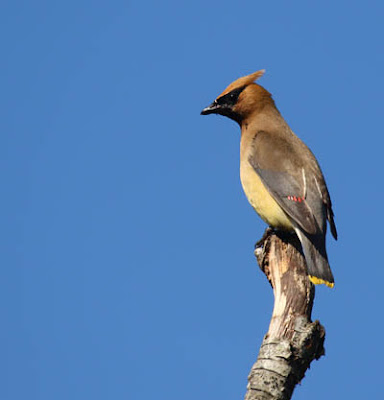 |
| Cedar Waxwing. Greg Gillson. |
Range in Illinois: Cedar Waxwings are year-round residents throughout Illinois.
Identification:
Size: Smaller than European Starling. Larger than House Sparrow.
Shape: Similar to European Starling. Rather stocky. Short squared tail, but long under tail coverts. Large head. Pointed wings. Wispy crest.
Bill: Rather short, small, wide.
Color: Warm brown above with wispy crest. Black mask. Yellowish belly. White under tail coverts. Gray wings. Gray tail with yellow tip.
Habitat, range, & behavior: Deciduous woods, wooded streams and lakeshores, residential shade trees, fruit orchards.
Resident across the northern US. Summer resident in Canada. Winter visitor throughout all of US and Mexico.
Keep in tight flocks. Feed in trees and large bushes for berries. Fly catch over ponds and streams.
Food and feeder preference: Berries and flying insects. Usually don’t come to feeders unless fruit like cherries offered but will visit bird baths.
26. Brown-headed Cowbird (Molothrus ater)
Cowbirds are small blackbirds lay their eggs in the nests of other smaller birds, such as warblers. The adoptive parents raise their young!
 |
| Brown-headed Cowbird. Greg Gillson. |
Range in Illinois: Brown-headed Cowbirds are summer residents throughout Illinois.
Identification:
Size: Larger than White-crowned Sparrows, but smaller than Rose-breasted or Black-headed Grosbeaks. Smaller than other blackbirds, starlings, and grackles.
Shape: Perhaps a little bit pot-bellied. Medium length tail. Flat forehead as typical for blackbirds.
Bill: Rather thick and stout.
Color: Males are glossy black with rich brown head. Females are dusty gray-brown throughout. Long-held juvenile plumage similar to pale female, scaly, being fed by Yellow Warbler or Song Sparrow or a hundred other host species.
Habitat, range & behavior: They are found in woodlands and farms. Also, with other blackbirds in winter at shopping center parking lots.
In summer they breed across Canada and most of the United States and Mexico. In winter they move south out of Canada and occupy both coasts and southeastern States in the US.
These small blackbirds join other flocks of blackbirds in cattle feedlots. You may see cowbirds riding on the backs of cattle, sheep, or horses. They originally rode on the backs of American bison on the Great Plains but expanded when forests were cut.
Food and feeder preference: Cowbirds eat grains, seeds, and insects. They will readily come to hopper and platform feeders. They are larger and more aggressive, so keep other birds from feeders and have a big appetite!
27. Northern Flicker (Colaptes auratus)
Of all the bird identification questions I get asked, this common larger backyard bird is the bird most people ask about. It doesn’t occur to those unfamiliar with it that this could be a woodpecker.
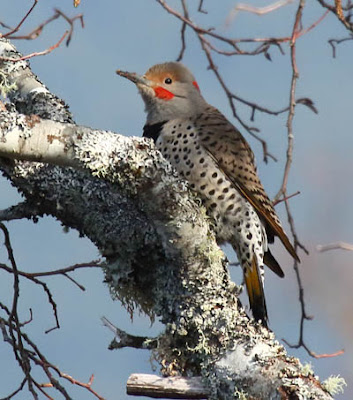 |
| Northern Flicker. Greg Gillson. |
Range in Illinois: Northern Flickers are year-round residents throughout Illinois.
Identification:
Size: About the size of a Mourning Dove. Larger than a robin.
Shape: Stocky with short legs, short tail, big head.
Bill: As long as head, thin, slightly curved.
Color: Back is brown with black bars. Under parts pinkish with black spots. Undersides of black wing and tail feathers are bright salmon red (West) or yellow (East). Head gray (West) or brown (East) and males with red (West) or black (East) whisker marks and nape marks (East). Black crescent across chest. White rump seen in flight.
Habitat, range & behavior: Found in woodland edges and forests.
Year-round resident from extreme southern Canada, across all of the lower-48 states and in the mountains of Mexico and Middle America. In summer breeds northward well into Canada and Alaska.
Frequently noted hopping on ground pecking in the ground for insects. In late spring, males proclaim their territory by rapid pounding on a hollow tree branch, though the ringing of metal downspouts at dawn is louder and carries much farther, to the exasperation of anyone trying to sleep inside!
Food and feeder preference: Ants and beetles are their primary foods. Will eat black oil sunflower seeds and are attracted to suet.
Common Birds in Illinois
To determine how common each species is I used the data from actual bird sightings from the citizen science program eBird. Birds are listed by frequency. That is, how often the species is recorded on checklists submitted to eBird (a percentage).
When choosing the birds to include in this article I leaned strongly to birds that are present throughout the year in good numbers. Thus, many of the common birds are year-round residents. This means that they live in the same location all year. They raise their young in your neighborhood. They don’t migrate. Or if the species does migrate, the ones living in your area don’t. If this is the case, some migrants may move into your area during certain times of year, adding to the same species that are in your yard full time.
Some migrant birds visit your yard during the “summer.” Often, they arrive in spring and remain until late fall. They nest and raise their young in your neighborhood. These are the summer residents.
Other migrant birds visit your backyard during the “winter.” Some of these winter visitors may arrive in July and remain into April. Others may only be found in the cold of December or January. They key here is that they nest and raise their young somewhere else. They only visit your yard in the non-breeding season.
Migration is an amazing spectacle.
There will be birds that fly through your region in spring or fall (or both). They may visit your backyard only a few days or weeks a year. They aren’t regular enough, or stay long enough, to be included in this article. But the number of briefly visiting migrant birds could double the number of species presented here. You may see them over time. Consult checklists in eBird for your county to see what is possible.
Most common backyard birds in Illinois throughout the year
The following list is the backyard birds that are, on average, most common throughout the entire year. The list is ordered by most common based on the frequency of how often each species is recorded on checklists submitted to eBird.
- American Robin (49% frequency)
- Northern Cardinal (49%)
- American Goldfinch (38%)
- Mourning Dove (34%)
- European Starling (34%)
- House Sparrow (33%)
- Downy Woodpecker (32%)
- Black-capped Chickadee (32%)
- Blue Jay (31%)
- American Crow (29%)
- Song Sparrow (28%)
- Red-bellied Woodpecker (26%)
- Common Grackle (24%)
- White-breasted Nuthatch (22%)
- House Finch (20%)
Most common backyard birds in Illinois in winter
1. Northern Cardinal (44% frequency)
2. Dark-eyed Junco (41%)
3. Downy Woodpecker (36%)
4. House Sparrow (34%)
5. Black-capped Chickadee (33%)
6. European Starling (30%)
7. American Crow (30%)
8. Mourning Dove (28%)
9. Red-bellied Woodpecker (26%)
10. American Goldfinch (25%)
11. White-breasted Nuthatch (24%)
12. Blue Jay (24%)
13. House Finch (21%)
14. American Tree Sparrow (20%)
Most common backyard birds in Illinois in summer
1. American Robin (61% frequency)
2. Northern Cardinal (46%)
3. American Goldfinch (43%)
4. Song Sparrow (39%)
5. Mourning Dove (35%)
6. Indigo Bunting (32%)
7. Common Grackle (32%)
8. European Starling (30%)
9. House Sparrow (30%)
10. Barn Swallow (29%)
11. Gray Catbird (28%)
12. Blue Jay (27%)
13. House Wren (26%)
14. Black-capped Chickadee (23%)
15. Downy Woodpecker (23%)
16. Tree Swallow (22%)
17. Eastern Wood-Pewee (20%)
18. Cedar Waxwing (20%)
How do birds in winter differ from birds throughout the year as a whole? In winter Dark-eyed Juncos and American Tree Sparrows are more common.
How do birds in summer differ from birds throughout the year as a whole? In summer American Robins, Indigo Buntings, Barn Swallows, Gray Catbirds, House Wrens, Tree Swallows and Eastern Wood-Pewees are more common.
Common Backyard Birds of Chicago, Illinois
 |
| Rock Pigeon is a common bird in Chicago. Greg Gillson |
- American Robin (56% frequency)
- Northern Cardinal (50%)
- House Sparrow (47%)
- European Starling (41%)
- American Goldfinch (39%)
- Red-winged Blackbird (36%)
- Black-capped Chickadee (34%)
- Downy Woodpecker (33%)
- American Crow (30%)
- Mourning Dove (28%)
- Common Grackle (28%)
- Song Sparrow (27%)
- Rock Pigeon (23%) Learn about this species on eBird
- Blue Jay (21%)
- Dark-eyed Junco (20%)
- House Finch (20%)
Really, then, the birds of Chicago match closely the birds of Illinois as a whole.
Red-bellied Woodpecker and White-breasted Nuthatch don’t reach 20% frequency in Chicago.
House Sparrow, European Starling and Rock Pigeon are more common in the Chicago region than the state as a whole, as one would expect for a more urban area.
Wrapping Up
As well as birds in your backyard, Illinois offers some great walks in stunning forests where you can find a rich diversity of forest birds, with over 200 species documented in various woodland habitats across the state. Here are some of the most common forest birds you might encounter:
Songbirds:
- American Robin: These familiar red-breasted thrushes with black heads are abundant in forests, parks, and backyards. Their cheerful songs brighten the woodland atmosphere.
- Wood Thrush: These beautiful brown thrushes with spotted chests prefer dense woodlands and ravines. Their melodious flute-like song is a delight to hear.
- Yellow Warbler: These bright yellow birds with distinctive white wing bars frequent various wooded habitats, including forest edges and thickets. Their sweet, bubbly songs add vibrancy to the forest soundscape.
- Cardinal: These striking red birds with black masks are common sights in Illinois forests and thickets. Their loud, clear songs are a powerful declaration of territory.
- White-breasted Nuthatch: These active little acrobats with black caps and white vests climb tree trunks searching for insects and nuts. Their nasal “pink-pink” call is a hallmark of many woodlands.
Woodpeckers:
- Downy Woodpecker: These small black and white woodpeckers with white chests tap rhythmically on tree trunks seeking insects. Their high-pitched drumming sound is a common forest melody.
- Hairy Woodpecker: Slightly larger than the Downy, these woodpeckers have a black patch on their cheek and a longer bill. Their drumming is deeper and more resonant than the Downy’s.
- Red-bellied Woodpecker: These medium-sized woodpeckers with red bellies and black and white plumage favor mature forests. Their loud, rolling “drumrolls” echo through the woods.
Frequently Asked Questions
What is the state bird of Illinois?
The state bird of Illinois is the Northern Cardinal (Cardinalis cardinalis). This vibrant red bird, with its black mask and crest, was officially chosen in 1929 after a vote by schoolchildren across the state.
Cardinals are common year-round residents in Illinois, thriving in various habitats like forests, open fields, parks, and even backyards. Their loud, clear songs and striking plumage make them easy to recognize and a beloved symbol of the state’s natural beauty.
Interestingly, Illinois was the first of seven states to choose the Northern Cardinal as its state bird, with the others being Indiana, Kentucky, North Carolina, Ohio, Virginia, and West Virginia. This reflects the widespread popularity and symbolic significance of this charismatic bird across the eastern United States.
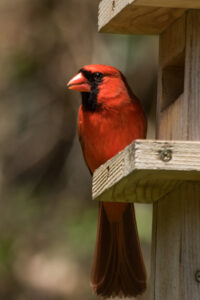
What kind of bird has a white belly in Illinois?
The ovenbird is a fascinating little songbird, belonging to the New World warbler family (Parulidae). Here’s a closer look at this intriguing bird:
Appearance:
- Size: Roughly the size of a large sparrow, measuring 11-16 cm (4.3-6.3 in) long with a 19-26 cm (7.5-10.2 in) wingspan.
- Coloration: Olive-brown back with spotted breast, giving it a camouflaged appearance for its forest floor habitat. Yellowish green crown with distinctive white stripes.
Habitat:
- Breeds in deciduous forests of eastern North America, primarily in the upper canopy but often descends to the forest floor for foraging.
- Winters in Central America, many Caribbean islands, Florida, and northern Venezuela.
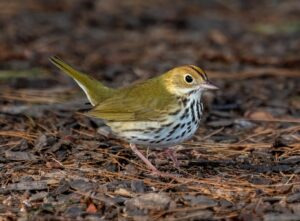
Behavior:
- Active on the forest floor, hopping and gleaning insects and other invertebrates from leaf litter and undergrowth.
- Renowned for its loud, rapid-fire song, described as “teacher-teacher-teacher,” often heard echoing through the forest during breeding season.
- Builds a distinctive domed nest with a side entrance, woven from leaves and resembling an old-fashioned outdoor oven, hence its name.
Significance:
- An indicator of healthy forest ecosystems, its presence suggests a diverse and thriving understory environment.
- A captivating bird for birdwatchers, with its charming personality, beautiful song, and fascinating nesting habits.
________________________________________________________________________________________________
Related Articles:
Birds at your feeder in Illinois
Feeding winter birds in Illinois
Red, Orange, & Yellow birds of Illinois
You may enjoy these other articles:
My review of the Nikon Monarch 7 8×42: I recommend these as the best birding binoculars under $500
My review of the Celestron Nature DX ED 8×42: I recommend these as the best birding binoculars under $200
Get started watching birds! Bird watching tips and equipment.
How to identify birds: 7 Steps to accurately identify birds






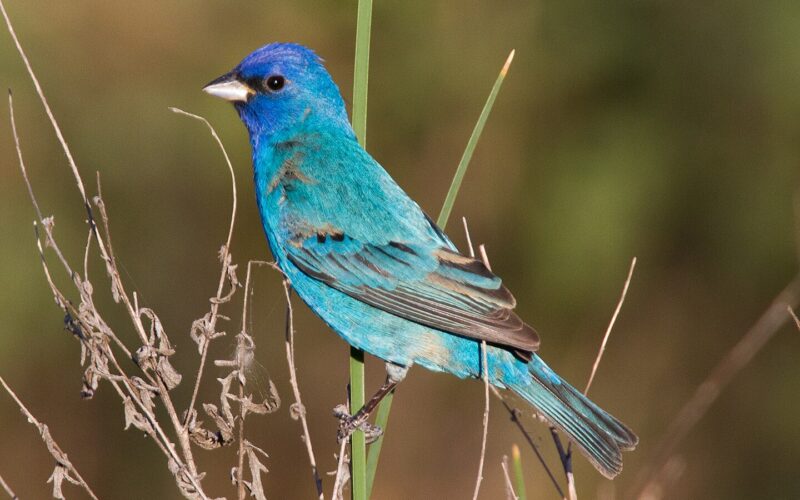
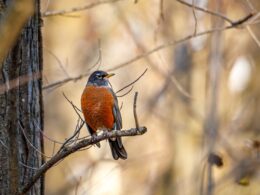
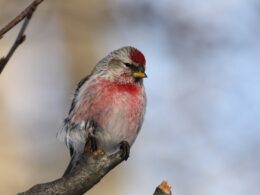
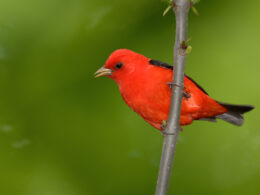
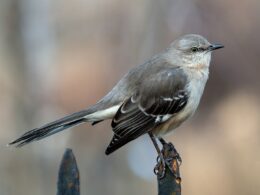
Beautifully done!
A very thorough list.. I’m putting together a nature journal for my kids and this was very helpful. Thank you!
Thank you so much for your compliments and helping me learn who my audience is! It is so important that our children get an education in nature. Sadly it doesn't often come from formal schooling. Good job!
This is very helpful and thorough. Just curious what less common birds are in the Chicago area.
Trying to help a friend ID a bird family being watched in birdhouse.
Literally hundreds of birds may be found in the Chicago area. Follow the instructions in the main text for birds "beyond your backyard." Go to eBird and enter Cook County and look at the abundance bar charts.
House Finch, House Sparrow, House Wren, Starling are the first to come to mind.
A swallow, bluebird, chickadee, nuthatch will all use nest boxes.
Thank you for this list and pics. I've been trying to make my backyard Cardinal friendly for breeding and learned what a threat House sparrows can be when i sW a group of them lined up on a fence chirping at a mama cardinal in her nest….
You are very welcome!